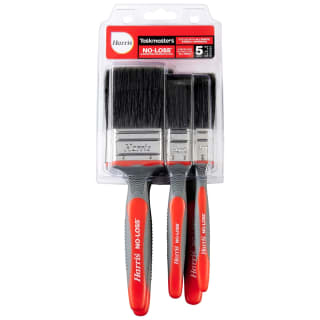B&M's Interior Paint Buying Guide
25 March 2019
Whether your home is a new build or you’re just planning to upgrade your property by giving it a makeover, looking into paints for your walls and ceiling is one of the most exciting steps. The colours and finishes you choose will give your home its very own personality and feel, so be sure to think carefully about your options. Here at B&M, we've created a handy guide on how to choose paint colours for your home.
How to Choose Paint Colours for Your Home

There are a number of elements to consider when looking into wall and ceiling paints:
1. How big is the space?
Most property owners wish to make the most of the space they have - so it’s usually best to paint smaller rooms in lighter colours where possible. You can afford to be braver and go darker in large rooms, however.
2. What style of décor are you considering?
When it comes to the style of your home, the typical guidelines state that for traditional cottage or farmhouse type properties, natural and neutral colours often work best. Off-whites and creams look great on rustic walls and against natural wood, and soft greens, rust-colours and subtle browns and caramels work beautifully for highlights and touches of colour.
If you’re after something more stately, but still traditional, you can go bold and opt for terracottas, forest greens and royal blues - though use these colours sparingly and choose one large wall or a single room in which to use this colour. Dark-treated woods look great against these shades.
In modern-style homes, picking a feature wall for bold hues is a great idea. Create a focal point with fun, bright block colours and choose more subdued, complementary shades for the rest of each room.
Pure whites, soft greys, neutral colours and metallics work very well for minimalist homes, as the focal points will be the craftsmanship of the property and the layout of the furnishings rather than any luxurious décor - bright colours are likely to prove distracting if you opt for minimalism.
3. What else will be on the surfaces you’re planning to paint?
If you’re planning on displaying bold artworks on certain feature walls, it may be best to keep those surfaces a simple, neutral colour. On the other hand, if a wall is to be broken up using panelling or exposed brick, you may find that there is an opportunity to go a little bolder with the colour you choose, as the effect will be softened by the presence of other materials.
4. What will adjoining rooms look like, what colours will they be and how do the spaces connect?
Try to make sure that there is a basic colour scheme running through your home that complements its style and furnishings. Aim for no more than three main colours throughout if you want a truly cohesive look. If rooms are semi-open plan, be sure that there are no clashes between the colours in each space as one will often be visible from the other.
5. Are you planning to keep any existing features, fittings or furniture?
Most of the time you'll simply be changing the colour of the walls and ceilings in any room, however if you're doing away with existing furniture and starting from scratch, then it's worth thinking about the colour of your new sofa, what kind of picture frames will be hung up and the tone and texture of your freshly laid carpet or flooring.
There’s a great deal of psychology that goes into the recommended choices of paint colour and style for each space. Read on for some tips on how to choose paint for each room.
How to Choose a Paint Colour for the Kitchen

Dos: if your kitchen is small or minimalist in style, white or off-white is always a safe and stylish choice. Think about the colours of your fittings - creams go better with natural wood units or tiling and furnishings with pink, red, brown or orange pigments, while ivories and purer whites look best with silver metallic surfaces, polished concrete or black or grey granite.
An unfussy colour scheme will give a sense of neatness and cleanliness, but if you want to go bold, a nice soft red or sunshine yellow will raise your spirits as you enter the room to prepare breakfast in the morning. Richer colours will also be a little more forgiving when it comes to hiding stains and sauce splashes!
Don’ts: Blue is an appetite suppressant, so be careful and sparing when using this colour in a space where food will be prepared or eaten.
How to Choose a Paint Colour for the Bedroom

Dos: Be sure to complement the colours of the bed frame, wardrobe and other furnishings with your wall shades. Warm, soft colours always work well in bedrooms - and if you’re hoping to create a nice, cosy feel, it’s worth experimenting with deeper, darker colours on at least one wall or corner should the space be a good size. Aubergines and crimsons are often popular.
Don’ts: Very bright colours can be somewhat blinding to someone who has just woken up, and blues or greys can make a room feel cold. Use small amounts of these colours, or a softer tone, if you really wish to.
How to Choose a Paint Colour for the Living Room

Dos: The reception rooms in your home usually offer more varied options, though the shade you choose should still complement the size and style of the space. If your furniture or décor is particularly ornate or bold, choosing softer, lighter colours for the walls is always the best idea. Warm colours or accents are also recommended here, or, if you’re considering blues, greys and other cold colours, try to contrast them with something a little warmer to take the edge off.
Don’ts: Too many clashing or contrasting colours can be distracting and give the room the feeling of imbalance.
How Much Paint do You Need?
Most paint tins will bear instructions on them informing the user of how much paint will cover a certain area of wall. Remember, the majority of paints require two coats, but the guidelines will usually take this into account.
5l of most types of interior paint should cover between 60 and 70 square metres of wall space, but always remember to check.
Choosing the Right Finish
The most popular paint finishes are gloss, satin or matt. Gloss reflects light the best and will work well in smaller spaces to give them the impression of greater size - however, too much gloss can be a little overbearing, so it may be best to use this type of paint for a feature wall in a modern home and contrast it against less reflective surfaces.
Matt paint is great for creating a more rustic look - particularly on curved or characterful plasterwork. It’s also currently exceptionally popular in minimalist design, as it creates flat, simple and unapologetic-feeling surfaces that provide the perfect backdrop to elegant furniture.
Satin paint is a great choice for those who wish to achieve a deep, dynamic colour in either a traditional style home or a modern property. It has a slight sheen that creates interest without being distracting or too bold.
For areas with greater amounts of foot traffic or spaces that are more likely to attract dirt or stains, like the kitchen, choosing scuff-proof or dirt-resistant paint may seem like an expensive option, but it will save you a great amount of time and effort when cleaning.
How to Choose the Right Paint Brush

Look for soft-bristled trim or wall brushes of 1 - 4” wide if you need to cover large surfaces with paint. Rollers are also excellent, as they’ll prevent bristle marks from being left. 1 - 2” wide sash brushes, either angled or flat, are perfect for “cutting in” or finishing off areas around windows and other features.
Don’t use natural bristled brushes with water-based paint as they’ll clog up, but they’re fine with oil, shellac, polyurethane and varnishes. Polyester or nylon bristles, or a combination of the two, are great for latex paints.
B&M Top Tip: If you’re still not sure how to choose paint colours for your home, take a look at B&M’s selection of paints online or in store for inspiration.
Share images of your newly decorated home with the B&M Community via Twitter, Facebook or Instagram.







